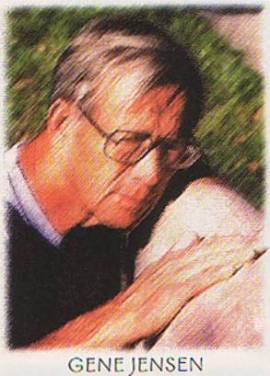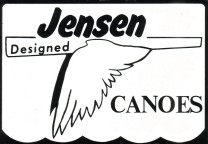Canoe Jornal - 1998
GENE JENSEN IS TO CANOE DESIGN WHAT BILL GATES IS TO SOFTWARE: he may not have started it, but his changes will be felt forever. Jensen, 69, single handedly revolutionized marathon racing, and by extension helped propel recreational canoeing into a renaissance of sleekness and efficiency. The bent‑shaft paddle, hallmark of marathon and sprint paddling, was the brainstorm of this innovative man. That was just one contribution. Boat designs, paddle technique, and racing strategy were others.
Jensen's distinguished marathon racing career began during his teenage years in the late 1940s with a 500‑mile race on the upper Mississippi from Bemidji to Minneapolis. His first foray into design was a 1,000‑mile Greyhound bus ride from his home in Minnesota to the Peterborough Canoe Company in Canada. He wanted them to build him a faster, longer canoe. They didn't pay too much attention to the 17‑year‑old, however, and he returned home empty‑handed. "I told my partner, 'It looks like we'll have to make our own boat.'" They built the better boat, of course, and success followed success over the next few decades as they turned out increasingly faster hulls. "Gene's biggest ability was the speed at which he could construct a design," recalls Mike Cichanowski, the founder of We‑no‑nah Canoe and the primary manufacturer and promoter of Jensen's boat designs. "He's a handyman and a prolific builder. Some guys will work on a design for years, but Gene will put something together in five days. And he knew how to win a race."
Racing remained at the heart of Jensen's quest for design efficiency. He and a partner were among the first to switch paddling sides for steering rather than depending on water‑dragging correction strokes like the "J." In 1949 they began employing the technique, using a quick "hut" call adopted from the military to signal a switch. Jensen remembers how other racers took note. "The next year, all you could hear at the starting line was 'hut, hut, hut, hut.'"
It wasn't until 1971, though, that Jensen got the idea for a bent‑shaft paddle. "I was racing against these two guys, strong guys, and watching them. It looked like they were just lifting water at the end of their stroke." He started experimenting with a bent shaft, which seemed more efficient. Later that year, Jensen showed up at a local race on Minnesota's Elk River with his new invention. "I got a lot of laughs from other paddlers. They thought I'd lost my mind." But using those wacky‑looking paddles, he and his partner won that year's International Classic in Quebec. Within two years, bent‑shaft paddles had become de rigueur for every serious racer on the circuit.
Jensen's boat designs have also become legendary, thanks in part to Mike Cichanowski. Because he was also a racer, Cichanowski immediately understood the advantages of Jensen's designs and was willing to make the sometimes awkward manufacturing molds that they required. "I was lucky to have Mike," says Jensen. "He readily accepted my goofy ideas."
Those "goofy ideas," such as bent‑shaft paddles, tucked‑in gunwales that allow a paddler to make more efficient strokes (first suggested by a racing companion, Steve Petersen, and developed more fully by Jensen), and a variety of more subtle design changes, have left a permanent and significant mark on canoeing, from marathon racing to wilderness tripping.



